Experimental Research on the Low-Cycle Fatigue Crack Growth Rate for a Stiffened Plate of EH36 Steel for Use in Ship Structures
Abstract
:1. Introduction
2. Low Cycle Fatigue Crack Growth Experiment for Stiffened Plate
3. Result and Discussion
3.1. Experimental Results of Stiffened Plates with Single-Edge Crack
3.2. Experimental Results of Stiffened Plates with Central Crack
4. Conclusions
- (1)
- The fatigue crack growth life exhibits a strong correlation with CTOD, particularly under varying load levels. Equation (1) accurately defines the correlation between CTOD and the crack growth rate of EH-36 steel. This highlights the role of CTOD in describing the crack propagation characteristics of EH-36 steel subjected to low-cycle fatigue loading.
- (2)
- The presence of stiffeners imposes a significant constraint effect on the formation of cracks in the plate, leading to a notably smaller ΔCTOD for the stiffened plate specimen compared to the plain plate specimen, consequently reducing the crack propagation rate and increasing the low-cycle fatigue crack growth life.
- (3)
- The constraining effect of the stiffened plate on the crack is influenced by the crack tip position. When the crack tip is far from the stiffener, the ΔCTOD of the stiffened plate specimen continues to increase, indicating a minor constraining effect of the stiffener on the crack in the plain plate. As the crack tip moves closer to the stiffener, the constraining effect of the stiffener on the crack in the plain plate becomes significant. In the case of the specimen with a single-edged crack, ΔCTOD does not increase but decreases, and for the specimen with a center crack, ΔCTOD gradually approaches that of the plain plate specimen.
- (4)
- Further investigations are needed to explore the variation in the CTOD and crack growth rate under variable amplitude loading.
Author Contributions
Funding
Institutional Review Board Statement
Informed Consent Statement
Data Availability Statement
Conflicts of Interest
References
- Dong, Q.; Xu, G.; Zhao, J.; Hu, Y. Experimental and numerical study on crack propagation of cracked plates under low cycle fatigue loads. J. Mar. Sci. Eng. 2023, 11, 1436. [Google Scholar] [CrossRef]
- Dong, Q.; Lu, X.; Xu, G. Experimental study on low-cycle fatigue characteristics of marine structural steel. J. Mar. Sci. Eng. 2024, 12, 651. [Google Scholar] [CrossRef]
- Gan, J.; Sun, D.; Deng, H.; Wang, Z.; Wang, X.; Yao, L.; Wu, W. Fatigue characteristics of designed T-type specimen under two-step repeating variable amplitude load with low-amplitude load below the fatigue limit. J. Mar. Sci. Eng. 2021, 9, 107. [Google Scholar] [CrossRef]
- Wang, Q.; Huber, N.; Liu, X.; Kashaev, N. On the analysis of plasticity induced crack closure in welded specimens: A mechanism controlled by the stress intensity factor resulting from residual stresses. Int. J. Fatigue 2022, 162, 106940. [Google Scholar] [CrossRef]
- Sistaninia, M.; Kolednik, O. A novel approach for determining the stress intensity factor for cracks in multilayered cantilevers. Eng. Fract. Mech. 2022, 266, 108386. [Google Scholar] [CrossRef]
- Nassiraei, H.; Rezadoost, P. Stress concentration factors in tubular T-joints reinforced with external ring under in-plane bending moment. Ocean. Eng. 2022, 266, 112551. [Google Scholar] [CrossRef]
- Nassiraei, H.; Rezadoost, P. Probabilistic analysis of the SCFs in tubular T/Y-joints reinforced with FRP under axial, in-plane bending, and out-of-plane bending loads. Structures 2022, 35, 1078–1097. [Google Scholar] [CrossRef]
- Nassiraei, H.; Rezadoost, P. Stress concentration factors in tubular T/Y-connections reinforced with FRP under in-plane bending load. Mar. Struct. 2021, 76, 102871. [Google Scholar] [CrossRef]
- Nassiraei, H.; Rezadoost, P. Static capacity of tubular X-joints reinforced with fiber reinforced polymer subjected to compressive load. Eng. Struct. 2021, 236, 112041. [Google Scholar] [CrossRef]
- Nassiraei, H.; Rezadoost, P. Stress concentration factors in tubular T/Y-joints strengthened with FRP subjected to compressive load in offshore structures. Int. J. Fatigue 2020, 140, 105719. [Google Scholar] [CrossRef]
- Dong, Q.; Yang, P.; Xu, G. Low cycle fatigue crack growth analysis by CTOD under variable amplitude loading for AH32 steel. Mar. Struct. 2019, 63, 257–268. [Google Scholar] [CrossRef]
- Dowling, N.E. Geometry effects and the J-integral approach to elastic-plastic fatigue crack growth. In Cracks and Fracture; Swedlow, J., Williams, M., Eds.; ASTM STP 601; American Society for Testing and Materials: Philadelphia, PA, USA, 1976; pp. 19–32. [Google Scholar]
- Gonzales, G.L.G.; González, J.A.O.; Antunes, F.V.; Neto, D.M.; Díaz, F.A. Experimental determination of the reversed plastic zone around fatigue crack using digital image correlation. Theor. Appl. Fract. Mech. 2023, 125, 103901. [Google Scholar] [CrossRef]
- Dunham, F.W. Fatigue Testing of Large-Scale Models of Submarine Structural Details. Mar. Technol. SNAME News 1965, 2, 299–307. [Google Scholar] [CrossRef]
- Chen, L.; Chen, X. The low cycle fatigue tests on submarine structures. Ship Sci. Technol. 1991, 2, 19–20. [Google Scholar]
- Li, C. Research on low cycle fatigue properties of several types of steel for submarine pressure shell. Dev. Appl. Mater. 1986, 12, 28–37. [Google Scholar]
- Liu, Y.; Zhu, X.; Huang, X. Experimental research on low frequency fatigue crack propagation rate of 921A hull steel structure. J. Nav. Univ. Eng. 2008, 20, 69–74. [Google Scholar]
- Jandejsek, I.; Gajdoš, L.; Šperl, M.; Vavřík, D. Analysis of standard fracture toughness test based on digital image correlation data. Eng. Fract. Mech. 2017, 182, 607–620. [Google Scholar] [CrossRef]
- Zhang, W.; Liu, Y. Plastic zone size estimation under cyclic loadings using in situ optical microscopy fatigue testing. Fatigue Fract. Eng. Mater. Struct. 2011, 34, 717–727. [Google Scholar] [CrossRef]
- Vasco-Olmo, J.M.; Díaz, F.A.; Antunes, F.V.; James, M.N. Characterization of fatigue crack growth using digital image correlation measurements of plastic CTOD. Theor. Appl. Fract. Mech. 2019, 101, 332–341. [Google Scholar] [CrossRef]
- Belytschko, T.; Black, T. Elastic crack growth in finite elements with minimal remeshing. Int. J. Numer. Methods Eng. 1999, 45, 601–620. [Google Scholar] [CrossRef]
- Melenk, J.M.; Babuška, I. The partition of unity finite element method: Basic theory and applications. Comput. Methods Appl. Mech. 1996, 139, 289–314. [Google Scholar] [CrossRef]
- He, L.; Liu, Z.; Gu, J.; Wang, J.; Men, K. Fatigue crack propagation path and life prediction based on XFEM. J. Northwestern Polytech. Univ. 2019, 37, 737–743. [Google Scholar] [CrossRef]
- Tu, W.; Yue, J.; Xie, H.; Tang, W. Fatigue crack propagation behavior of high-strength steel under variable amplitude loading. Eng. Fract. Mech. 2021, 247, 107642. [Google Scholar] [CrossRef]
- Huang, X.; Zhang, X.; Bai, G.; Xu, W.; Wang, H. Residual strength analysis of thin-walled structures with multiple site damage based on crack tip opening angle method. J. Shanghai Jiao Tong Univ. 2013, 47, 519–524+531. [Google Scholar]
- Hwang, J.H.; Kim, H.T.; Kim, Y.J.; Nam, H.S.; Kim, J.W. Crack tip fields at crack initiation and growth under monotonic and large amplitude cyclic loading: Experimental and FE analyses. Int. J. Fatigue 2020, 141, 105889. [Google Scholar] [CrossRef]
- Xiong, K.; Deng, J.; Pei, Z.; Yang, P.; Dong, Q. Analysis of accumulative plasticity and fracture behavior of hull cracked plates subjected to biaxial low-cycle fatigue loading. J. Ship Mech. 2022, 26, 113–124. [Google Scholar]
- Wei, X. Fatigue Reliability Analysis of Ship Stiffened Panel Structure Subjected to Multiple Cracks. Master’s Thesis, Harbin Engineering University, Harbin, China, 2017. [Google Scholar]
- Soares, C.G.; Garbatov, Y.; Safety, S. Fatigue reliability of the ship hull girder accounting for inspection and repair. Reliab. Eng. 1996, 51, 341–351. [Google Scholar] [CrossRef]
- Duncheva, G.; Maximov, J.; Ganev, N.; Ivanova, M. Fatigue life enhancement of welded stiffened S355 steel plates with noncircular openings. J. Constr. Steel Res. 2015, 112, 93–107. [Google Scholar] [CrossRef]
- Lei, J.; Yue, J.; Xu, Z.; Fang, X.; Liu, H. Theoretical and Experimental Analysis on Low-Cycle Fatigue Crack Initiation for High Strength Steel Stiffened Plates. In Proceedings of the ASME 2022 41st International Conference on Ocean, Offshore and Arctic Engineering, Hamburg, Germany, 5–10 June 2022. [Google Scholar]
- Dexter, R.J.; Pilarski, P.J. Crack propagation in welded stiffened panels. J. Constr. Steel Res. 2002, 58, 1081–1102. [Google Scholar] [CrossRef]
- Jiang, W.; Yang, P. Experimental studies on crack propagation and accumulative mean strain of cracked stiffened plates under low-cycle fatigue loads. Ocean. Eng. 2020, 214, 107744. [Google Scholar] [CrossRef]
- Song, Y.; Yang, P.; Hu, K.; Jiang, W.; Zhang, G. Study of low-cycle fatigue crack growth behavior of central-cracked stiffened plates. Ocean. Eng. 2021, 241, 110083. [Google Scholar] [CrossRef]
- Dong, Q.; Yang, P.; Deng, J.L.; Wang, D. The theoretical and numerical research on CTOD for ship plate under cyclic loading considering accumulative plastic strain. J. Ship Mech. 2015, 19, 1507–1516. [Google Scholar]
- Deng, J.; Yang, P.; Dong, Q.; Wang, D. Research on CTOD for low cycle fatigue analysis of central through cracked plates considering accumulative plastic strain. Eng. Fract. Mech. 2016, 154, 128–139. [Google Scholar] [CrossRef]
- Dong, Q.; Yang, P.; Xu, G.; Deng, J.L. Mechanisms and modeling of low cycle fatigue crack propagation in a pressure vessel steel Q345. Int. J. Fatigue 2016, 89, 2–10. [Google Scholar] [CrossRef]
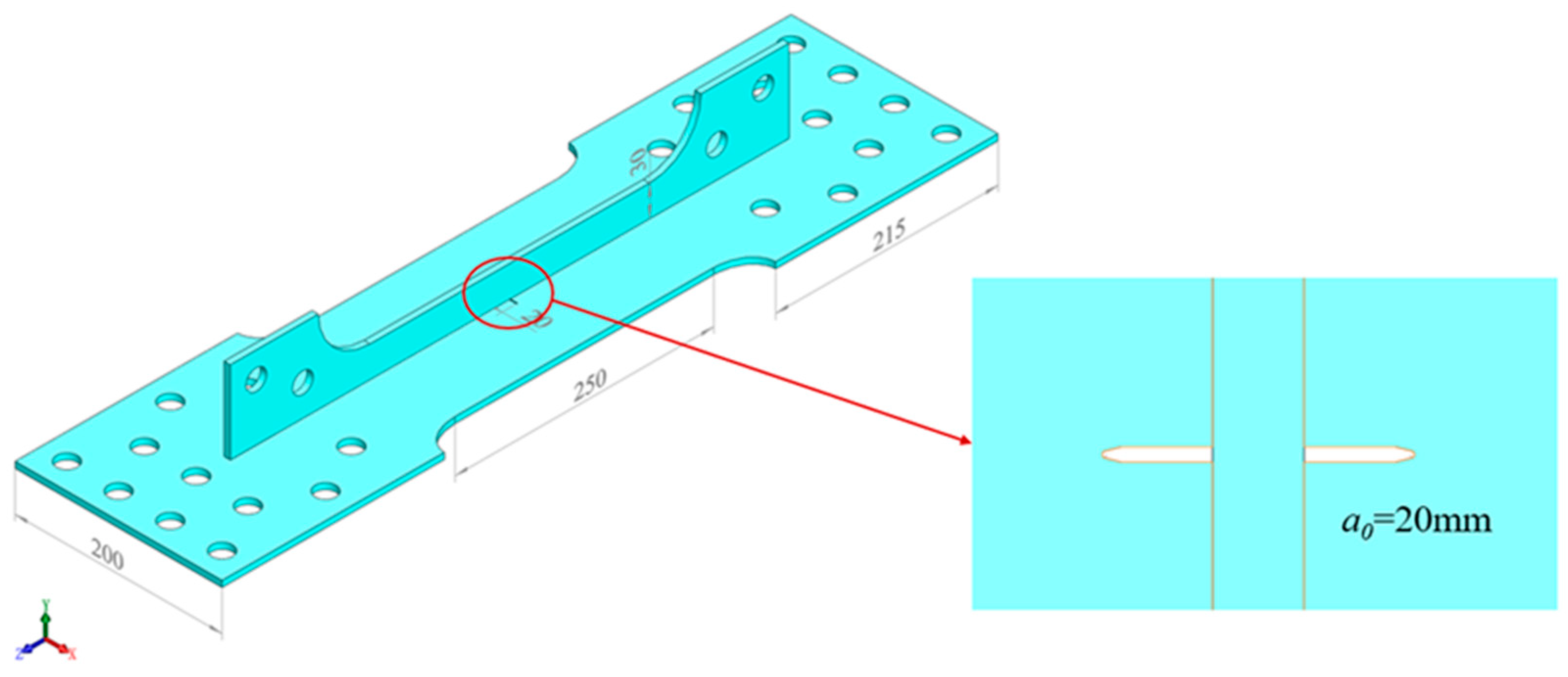
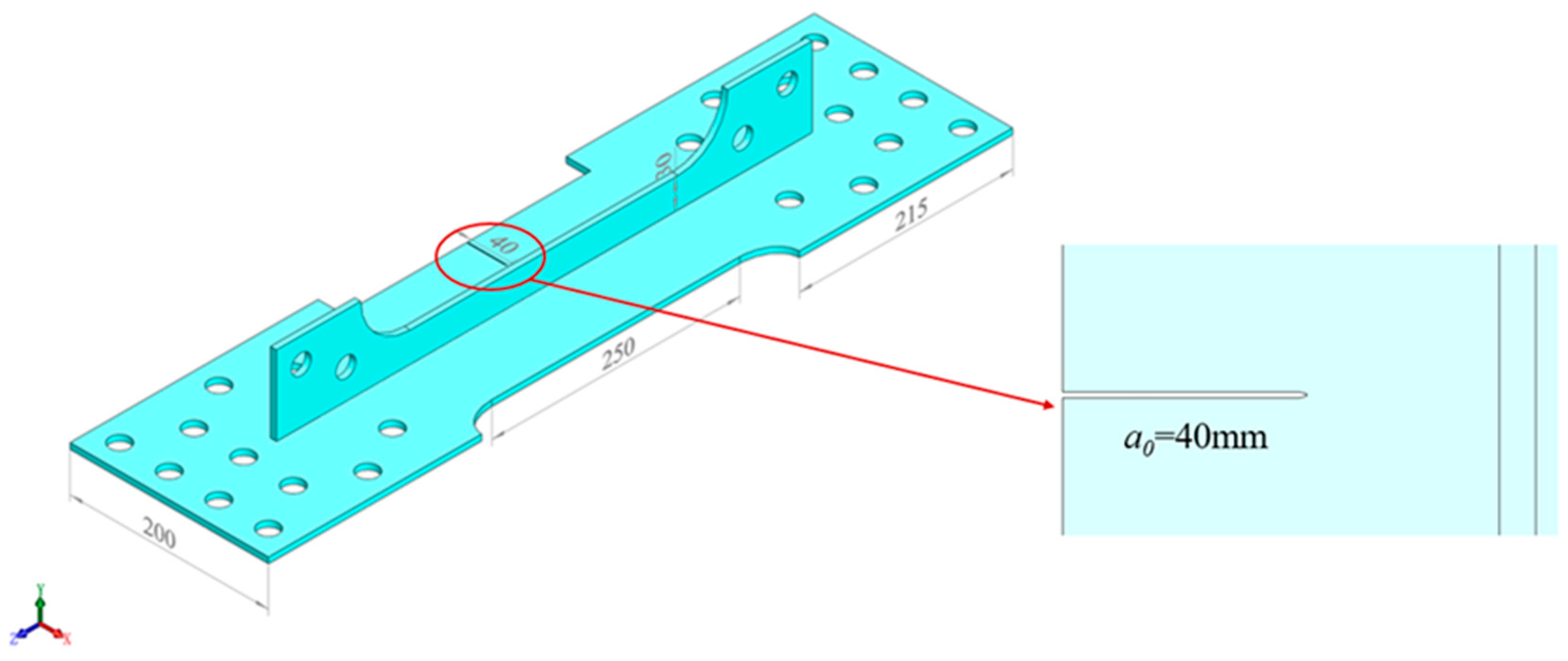
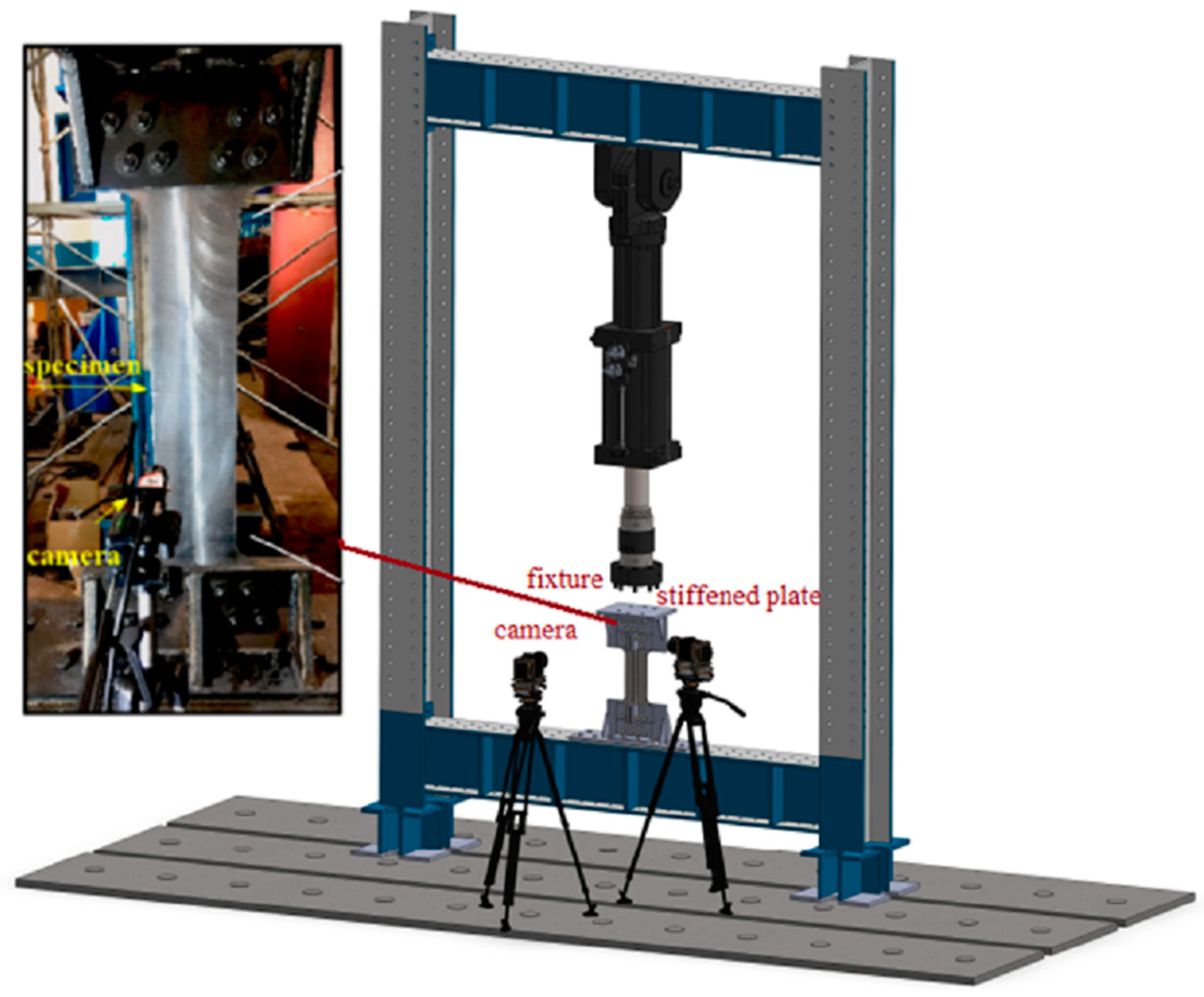
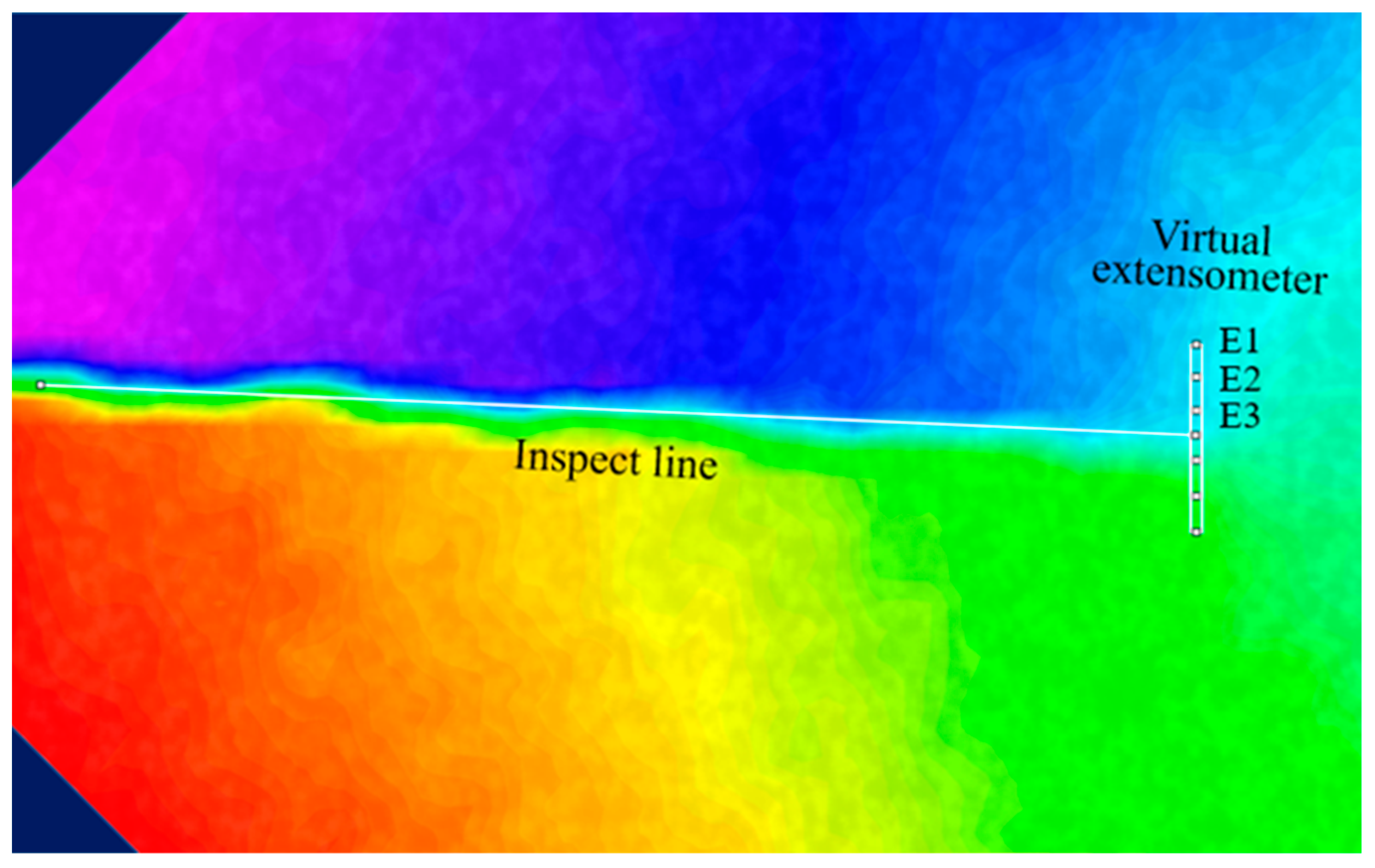

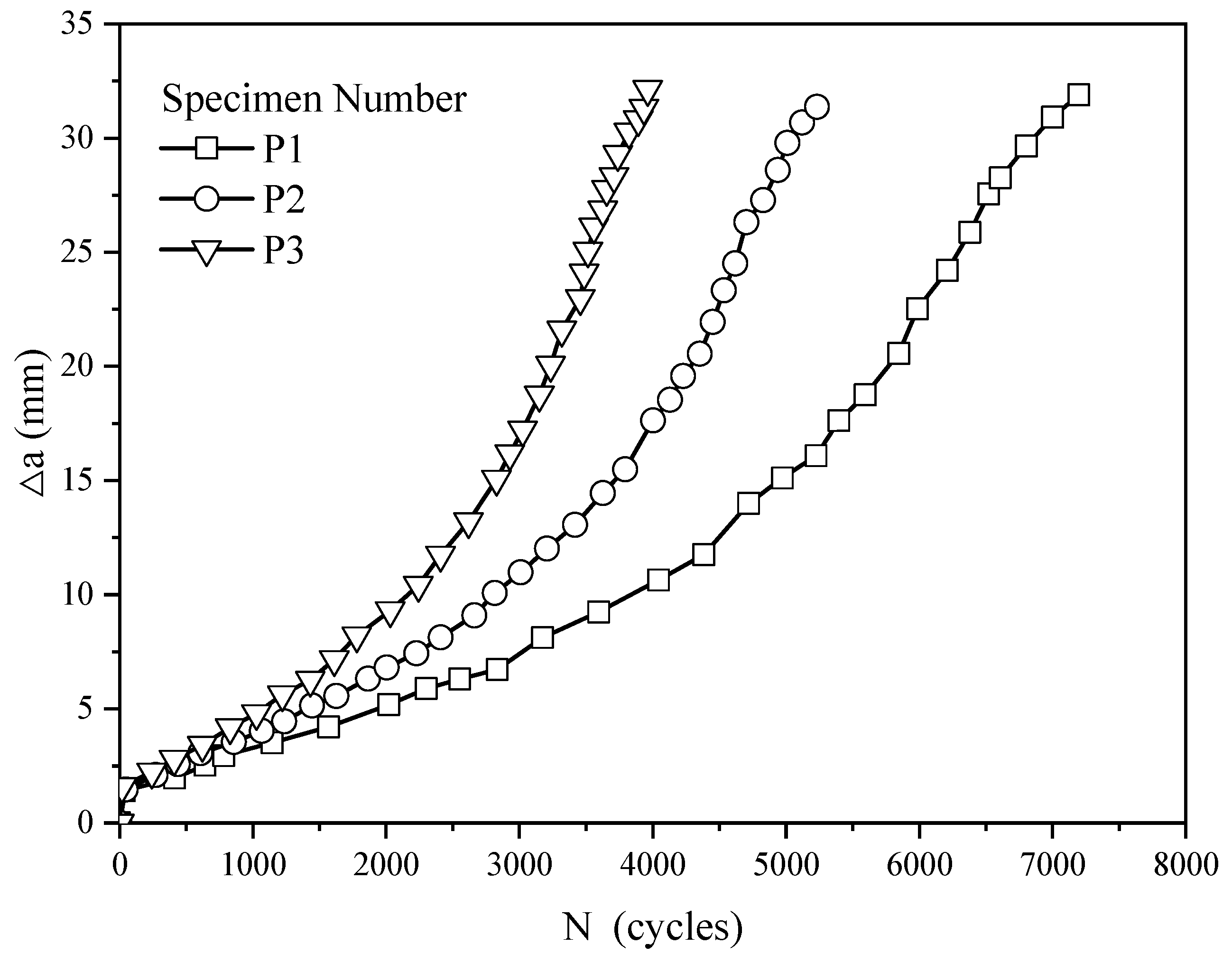

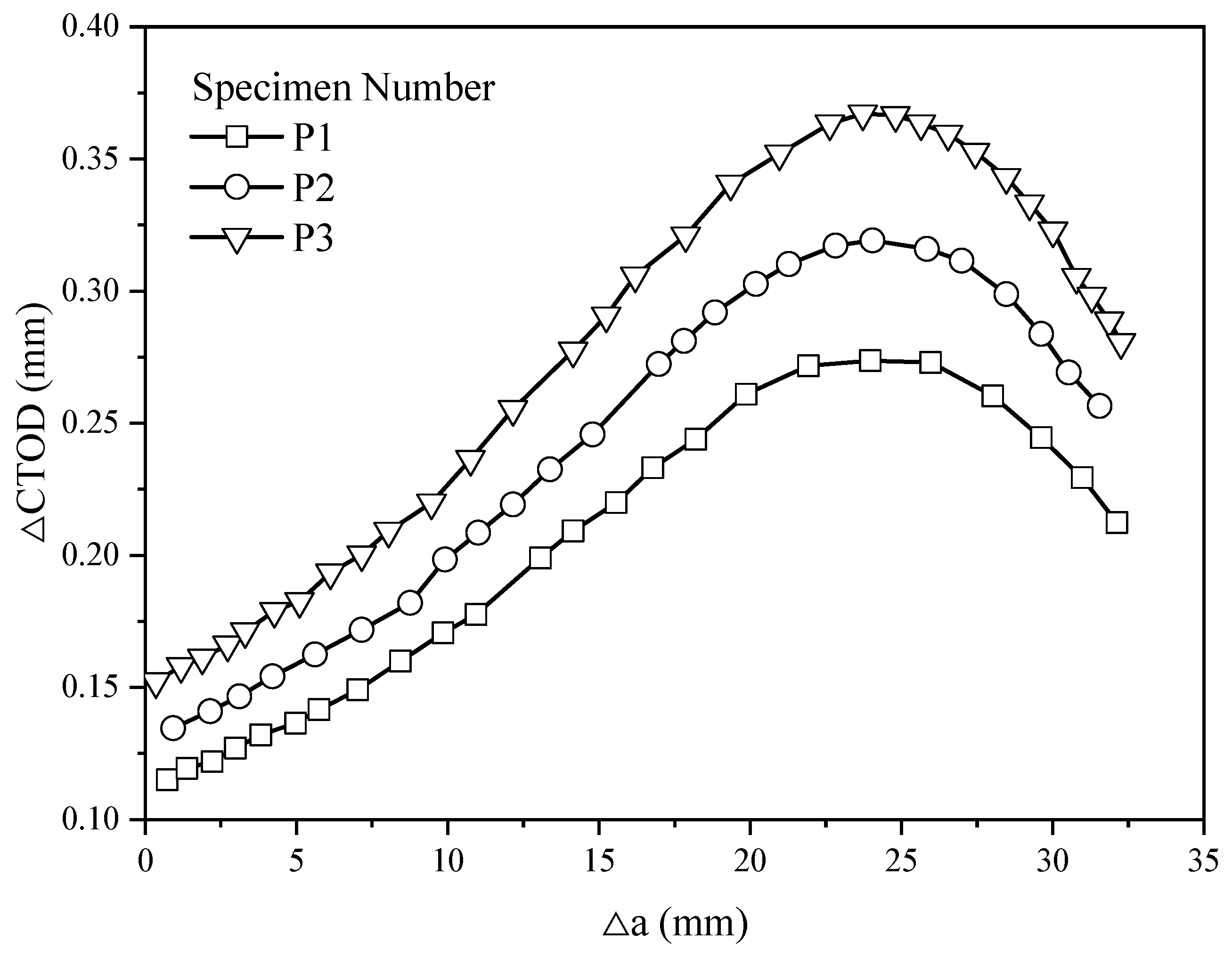
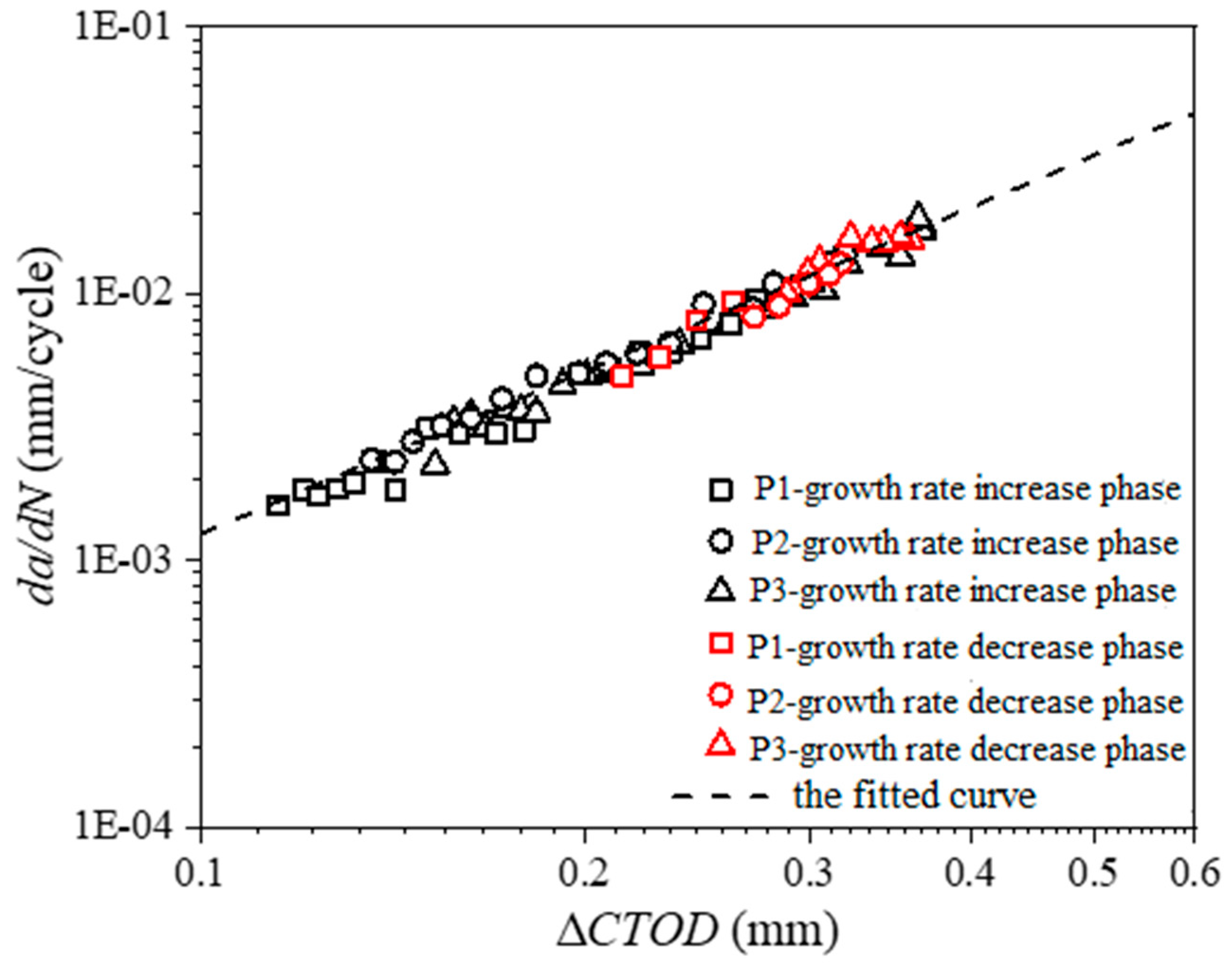
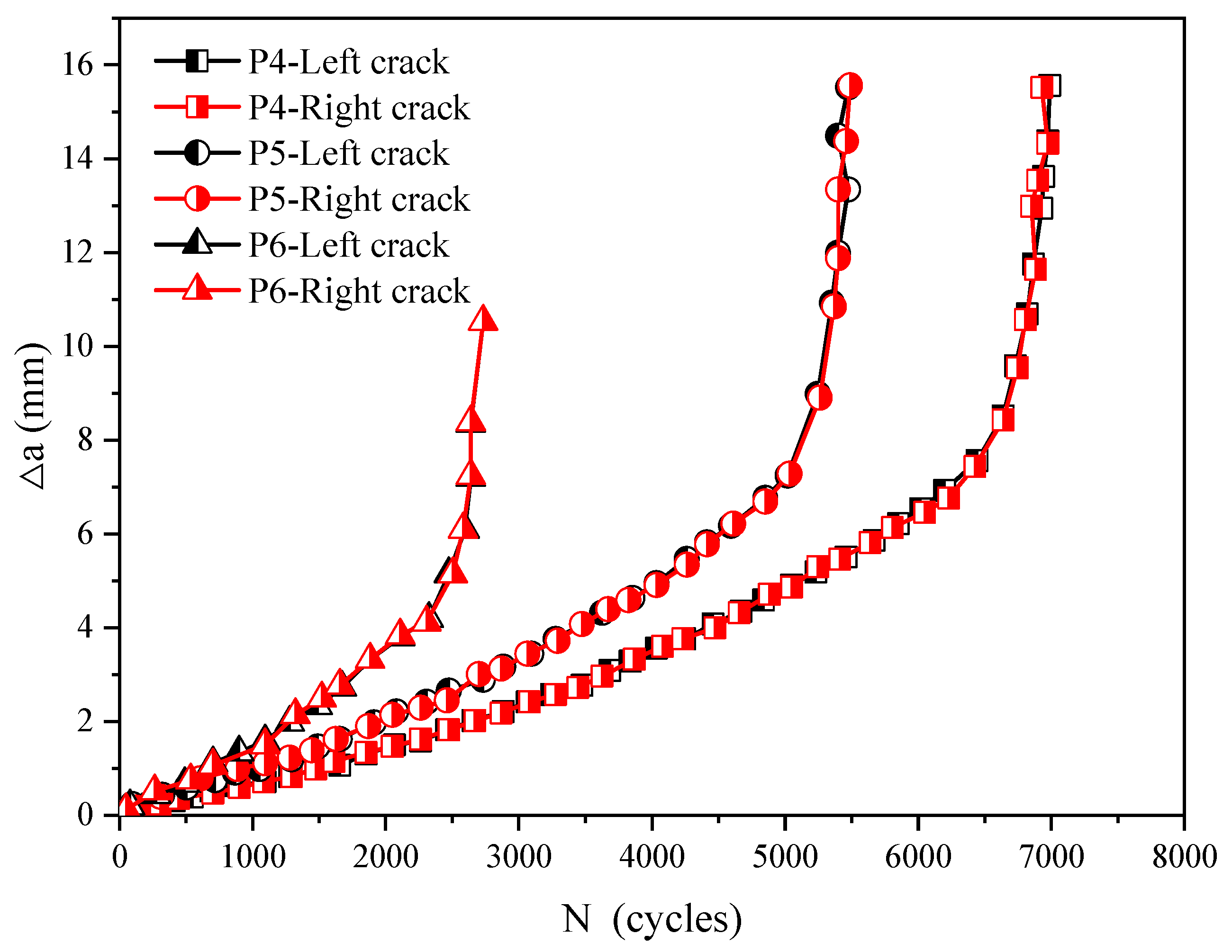
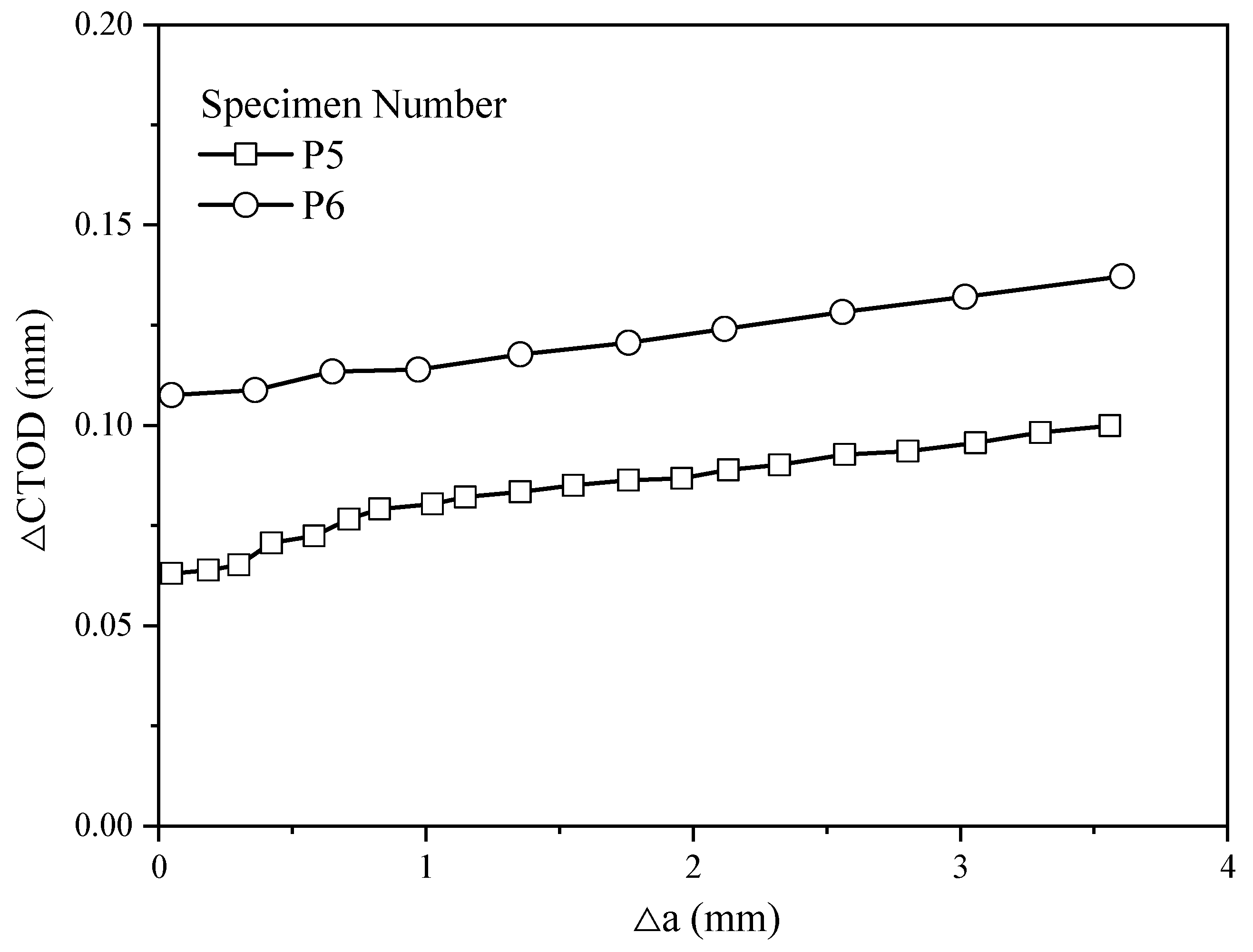
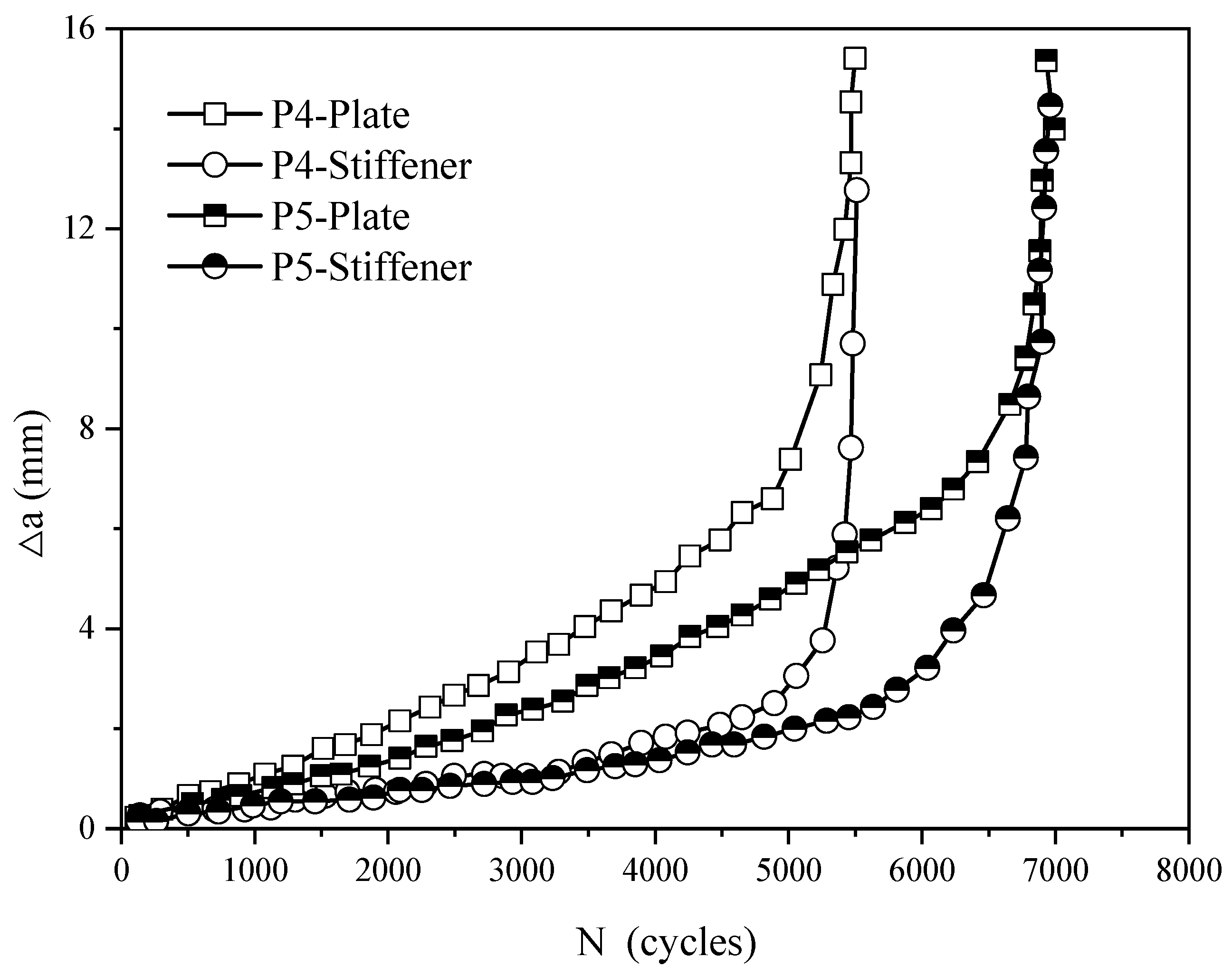
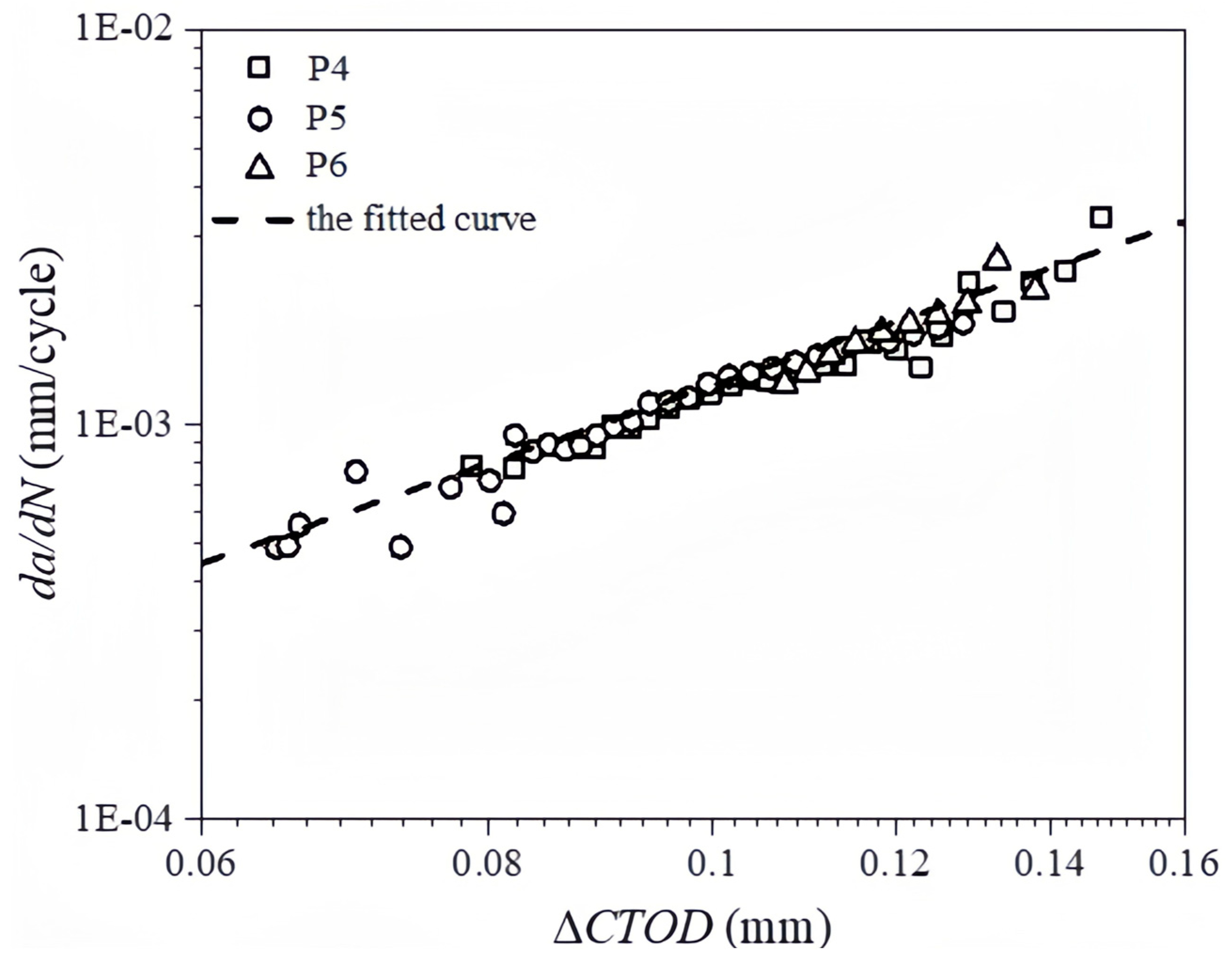
| Elastic Modulus/GPa | Poisson’s Ratio | Yield Stress/MPa | Ultimate Tensile Strength/MPa |
|---|---|---|---|
| 206 | 0.3 | 434.94 | 548.91 |
| Specimen Number | Pmax/kN | R = Pmin/Pmax | Nominal Stress/MPa | Crack Location | Stiffener Height |
|---|---|---|---|---|---|
| P1 | 84.24 | −1 | 120 | single-edge crack | 30 mm |
| P2 | 90.72 | −1 | 130 | single-edge crack | 30 mm |
| P3 | 97.20 | −1 | 140 | single-edge crack | 30 mm |
| P4 | 384.00 | 0.031 | 280 | central crack | 30 mm |
| P5 | 420.00 | 0.2 | 300 | central crack | 30 mm |
| P6 | 420.00 | 0.2 | 300 | central crack | 0 mm |
Disclaimer/Publisher’s Note: The statements, opinions and data contained in all publications are solely those of the individual author(s) and contributor(s) and not of MDPI and/or the editor(s). MDPI and/or the editor(s) disclaim responsibility for any injury to people or property resulting from any ideas, methods, instructions or products referred to in the content. |
© 2024 by the authors. Licensee MDPI, Basel, Switzerland. This article is an open access article distributed under the terms and conditions of the Creative Commons Attribution (CC BY) license (https://creativecommons.org/licenses/by/4.0/).
Share and Cite
Dong, Q.; Xu, G.; Chen, W. Experimental Research on the Low-Cycle Fatigue Crack Growth Rate for a Stiffened Plate of EH36 Steel for Use in Ship Structures. J. Mar. Sci. Eng. 2024, 12, 1365. https://doi.org/10.3390/jmse12081365
Dong Q, Xu G, Chen W. Experimental Research on the Low-Cycle Fatigue Crack Growth Rate for a Stiffened Plate of EH36 Steel for Use in Ship Structures. Journal of Marine Science and Engineering. 2024; 12(8):1365. https://doi.org/10.3390/jmse12081365
Chicago/Turabian StyleDong, Qin, Geng Xu, and Wei Chen. 2024. "Experimental Research on the Low-Cycle Fatigue Crack Growth Rate for a Stiffened Plate of EH36 Steel for Use in Ship Structures" Journal of Marine Science and Engineering 12, no. 8: 1365. https://doi.org/10.3390/jmse12081365







